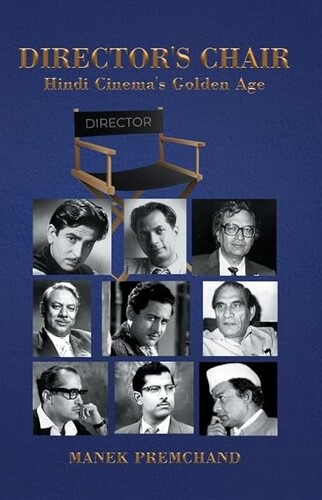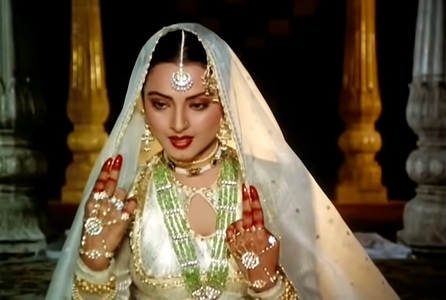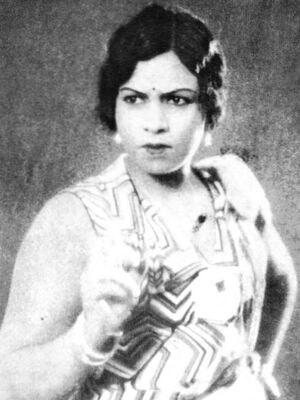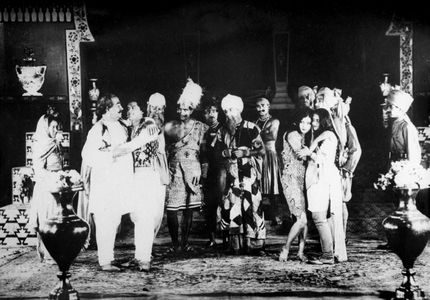Amongst all the many books on Hindi cinema I’ve read over the years, most have been about actors, or (rather more occasionally) composers, singers, or even lyricists. Biographies, autobiographies, analytical insights into their work. Meena Kumari, Balraj Sahni, Asha Bhonsle, Rajesh Khanna, Ashok Kumar, SD Burman, Majrooh Sultanpuri, Sahir Ludhianvi, Helen, Lata Mangeshkar, Dev Anand, and many others. By contrast with these, I can count on the tips of my fingers the number of books I’ve read about directors. Hrishikesh Mukherjee (by Jai Arjun Singh), Basu Chatterji (by Anirudha Bhattacharjee) and Nasir Hussain (by Akshay Manwani); even an autobiography by Kidar Sharma. But other than that? Not too many. Or none that I’ve read (though, I will admit, I am yet to read both Nasreen Munni Kabir’s and Sathya Saran’s books on Guru Dutt).
I was keen, therefore, to read Manek Premchand’s ‘Director’s Chair: Hindi Cinema’s Golden Age’ when its publisher, Blue Pencil Publishing, offered to send me a complimentary copy. I am of the firm belief that a director plays a huge role in making a film what it is: yes, everybody plays their part, but how so many disparate elements are brought together, how the sum becomes greater than its parts, is up to the director.
Director’s Chair is a bulky book, close to 600 pages, and I will confess I approached it with some trepidation: I envisioned a long slog. This book, after all, covers hundreds of directors (and no, as Premchand explains in his introduction to the book, that does not by any means include everybody who ever directed a Hindi film: just those who directed even one film that is by some measure noteworthy).
As its subtitle clarifies, this book focuses only on the directors of Hindi cinema’s golden age. Not all Indian cinema (though there are occasional glimpses of exemplary work being done in regional cinema, mostly in the context of directors like Satyajit Ray, SS Vasan, etc, who may have made forays into Hindi cinema but did their best work in a regional language). Not even Hindi cinema in its more-than-a-century of existence; only Hindi cinema from its inception up to 1980 (though in this case too there are passing mentions of films directed after 1980 by directors, such as Govind Nihalani or Muzaffar Ali, who first made a mark for themselves before the cut-off date for the book’s focus period).
After his introduction (in which Premchand also explains something of what a director really does, and is responsible for, plus how that differs from a producer’s job description), Premchand goes on to the first part of the book. This, The Early Masters, covers the starting years of the Hindi film industry and includes people like Dadasaheb Phalke, Ardeshir Irani (the director of India’s first talkie, Alam Ara) to other, equally successful and talented, directors who might have been forgotten by most over time. Chandulal Shah, for instance; or Baburao Painter. There is an interesting anecdote in the context of Baburao Painter which caught my eye: how it is thanks to him that entertainment tax began to be levied on films in India!
The directors enumerated in The Early Masters have been listed in alphabetical order, with (depending upon each director’s importance in the realm of Hindi cinema), something about the films they directed; a brief synopsis (where logical) of a landmark film or two; any pioneering films or innovations; and so on. For most of the directors, there is also some level of personal history involved, and it’s interesting to see what varied backgrounds these men (and a very few women, like Fatima Begum) came from, what careers they abandoned to enter cinema, and how cinema evolved in India.
The second section of the book, The Significant Virtuosos, is the largest section of Director’s Chair, spanning all of post-independence Hindi cinema up to 1980, and taking up more than 400 pages. This is where almost all of the more familiar names, the titans, come in: Bimal Roy, V Shantaram, Vijay Anand, Nasir Husain, Mehboob Khan, Raj Kapoor, Guru Dutt. And hundreds of others, from actors-turned-directors (Sunil Dutt for Yaadein and Reshma aur Shera, for instance) to flash-in-the-pan directors whose works have far outlived their makers.
The last few sections of the book are relatively shorter. There’s The Honourable Others, including people who directed the one-off film, or whose films didn’t make much of an impact. This is followed by Special Notes, which include films made by comedians (and so many of these! It seems pretty much all the comic actors, even those not especially successful, ended up directing films); films based on or inspired by published works; foreign nationals who directed Hindi films; remakes of films; various statistics about Hindi cinema across the decades, and other such trivia.
I enjoyed this book a lot. As I mentioned, it’s a long book, but one aspect of it which really works (besides Manek Premchand’s writing, which is easy reading) is that it’s not monotonous. If Premchand had discussed each director in exactly the same way, if the same format had been followed for all, it might have swiftly become a question of plodding through one biography after another. But that’s not how Director’s Chair is. Instead, what Premchand does is to keep it fluid, keep it varied. There are excerpts from reviews (that acerbic Baburao Patel is in evidence, but so are others). There are anecdotes, there are quotes.
For the big guns, the Mehboob Khans and Guru Dutts and Shantarams of the film world, there are detailed (and often extremely interesting) biographies, with fascinating insights into their lives and their work. There was trivia here that I hadn’t known. For example, that Mehboob Khan had done some pretty daring stunts in the days of the silent films, or that—if things had worked out differently—he might have been the star of India’s first talkie, Alam Ara (1931).
Or that Bimal Roy’s cinema had become very popular in the Soviet Union, or even that Kishore Kumar had been the (so hard to believe, despite Naukri) initial choice for the eponymous Anand of the Hrishikesh Mukherjee film. Or that Hemen Gupta (director of films like Kabuliwala, Ferry and Anand Math) was so ardent a freedom fighter, he even went to jail for his anti-British activities.
There is no set pattern, so a quick list of films, with a birth and death date, may suffice for one director, while pages and pages may be devoted to people like AR Kardar, Raj Kapoor, Vijay Anand and Chetan Anand, etc.
I won’t say that everything is completely flawless. There are a couple of slip-ups. Nargis’s character in Miss India, for instance, is described as a ‘frolicking tomboy’ in one place, a ‘flippant urban tomboy’ in another, both pretty much opposite to what this character really is, despite Jaise ko taisa nehle pe dehla. 1984 has been credited to Aldous Huxley (not George Orwell, its actual author); Shammi Kapoor’s character in Professor has been described as having been employed to tutor the two young women played by Kalpana and Praveen Choudhary (not actually; he is employed to tutor their little brothers; him ending up teaching the women Sanskrit happens as an afterthought).
But yes, there were few (very few) errors and just the occasional repetition: nothing, really, that came in the way of my enjoying this book. I liked it a lot: it was informative, engrossing, entertaining, inspiring. And I liked that Premchand doesn’t go overboard with the praise. He is very level, factual, and generally fairly objective when it comes to discussing these directors. For instance, he gives praise where it is due, and doesn’t hesitate to criticize the same director where that’s in order.
While reading this, I kept having to go online to check if possibly so-and-so film was available for viewing. By the end of it, I had added around five films to my watch-list on YouTube (and had searched for many more, all of which I have had to give up on as being among the ‘lost films’ of India).
Highly recommended. If you are interested in Hindi cinema of the yesteryears, do get this book: it’s not just a very good tribute to the directors who made all those films, but also, in its way, a guide to the cinema of those decades.








you can also read the books on Directors first films by Rakesh Bakshi. Nicely done. And waste no time. Read Ten Years with Guru Dutt Abrar Alvi’s Journey. I promise you that you will love it Sathya
LikeLiked by 2 people
Your book is definitely on my list, Sathya. Looking forward to reading it. And thank you for telling me about Rakesh Bakshi’s books; I hadn’t known about those.
LikeLike
We live and learn, Madhulika 🥰
LikeLiked by 1 person
:-) And I’m always happy to get book recommendations.
LikeLike
It seems like a wonderful book for the lovers of Indian Cinema.
I used to be very interested in Indian cinema, so much that I would buy all those filmy magazines and read every single page. People found it amusing how I instantly recognized old, lesser known actors (even side characters) whose name nobody (of my generation) knew. But I haven’t read any proper books on Cinema, maybe because I don’t really enjoy reading nonfiction.
But yes, as you said (and I strongly believe) that writing style makes a big difference. I have read a biography of Sanjay Dutt, which I enjoyed, but later it turned out that it wasn’t really an authentic biography (as the author didn’t interview Sanjay Dutt), but it was based on articles and interviews published over the years.
And Hrishikesh Mukherjee and Basu Chatterjee’s movies were SO good! They had a signature style, I think. Sadly, they don’t make those kinds of movies anymore.
Yesterday, I read a very interesting epistolary short novella, The Exception of the Rule’, by Christina Lauren (from Valentine’s Day series). It was recommended by someone on Twitter because it’s very similar to Love Virtually, and we both love that book. :) I picked another book in the series but that was very unconvincing, so I left it unfinished.
LikeLiked by 1 person
Yes, for anybody who’s as deeply interested in old Hindi cinema – not just watching old films, but interested in the people who made them and the times they were made in – this book is invaluable.
I totally agree re: the films of Hrishikesh Mukherjee and Basu Chatterji: SO good indeed. I love the way both of them managed to portray real life in such a heartwarming, relatable way. Manek Premchand calls it ‘escapism’ of a different sort, and I couldn’t agree more.
Thank you for the Christina Lauren novella recommendation! I’ve wishlisted it on Amazon, will buy as soon as I’m through the tome I’m plodding through right now. :-)
LikeLiked by 1 person
Escapism is an apt term for Hrishikesh Mukherjee and Basu Chatterjee’s movies.
Re Christina Lauren novella: you can read it for free if you have a prime subscription. You might finish it in one or two sittings. But yes, it’s a good idea to first finish the books that we already have.
LikeLiked by 1 person
Thank you for that tip! My husband does have a Prime account, so I’ll use that. Right now, I’m reading a very difficult book, but I can’t afford to stop reading since this one is for a commissioned review. Once I’m done (hopefully this weekend), I will give myself a treat by reading the Lauren.
LikeLike
Thank you for such an encouraging review! Clearly you found the patience to read the book cover to cover. Short extracts of your reviews of films like Night In London grace the pages of this book, for which I thank you again. About the book 1984, I wonder why I credited it to Alduous Huxley and not to George Orwell, as you rightly mention. Perhaps because both are dystopian novels written by English writers. Perhaps I was cross-medicated when writing that! Surprisingly my learned editor missed this glitch too! I’m requesting my publisher to effect that change asap. About Nargis, her role in Miss India, released in the same year as her iconic Mother India, 1957, showed her like a tomboy prancing about and singing Albela main ik dilwala. Her character here was a polar opposite of the suffering rural woman in Mother India. That made me speak of her that way. I sign off by asking you to bring out a compendium of your own remarkable reviews of books and films.
LikeLiked by 1 person
I wonder why I credited it to Alduous Huxley and not to George Orwell.
I can completely relate to that – in fact, something very similar happened to me the other day, when I credited Tasveer banaata hoon to Naushad, while knowing perfectly well that it was composed by Nashad. I think sometimes our brains go on the blink. :-)
Congratulations on a book very well done, I wish all the best for it!
LikeLiked by 1 person
Grateful 😊 🙏
LikeLiked by 1 person
Going to buy of course!
A must for a blogger like me. I already have a few of his book and he’s wonderful!
Thanks for the review. Helps the readers take a right decision!
Anup
:-)
LikeLiked by 1 person
I am glad you enjoyed this review, Anupji! Yes, do buy – it’s a very good book, as you can see from my review.
LikeLike
Madhu,
I am halfway through the book and I must say the book is an excellent compendium. While being a compilation of profiles of hundreds of directors, it takes you through the fascinating history of cinema from the silent era.
I have reviewed some books of Manek Premchand. After your excellent review I would have to see if I can add anything new.
AK
LikeLiked by 1 person
I am looking forward to seeing your review of the book, AK. And yes, I agree that it’s a fascinating peek into silent cinema in particular. Because of this book, I have bookmarked a couple of silent Hindi films on YouTube; let’s see when I get around to watching them…
LikeLike
Waiting to get my hands on my copy, Madhu. Your excellent review has whetted my interest in it.
(And I could swear I had already commented on this review since I read it when you posted!)
LikeLiked by 1 person
I’m glad you enjoyed this review, Anu. I’ll be looking forward to seeing what you have to say about this book!
LikeLike
Madhuji, reading about cinema of yesteryears is always a pleasure. I feel that directors who were also producers would perhaps have a different outlook as they have to manage the cost of film making alongside the creative part. I will try to lay my hands on this book. Thanks a lot for the review!
LikeLiked by 1 person
I’m glad you enjoyed this review. I agree, directors who were also producers (and vice-versa) must have had to cultivate a very different type of outlook, and perhaps when they donned only one of those avatars they were better able to empathise with the constraints the other had to work under.
LikeLike